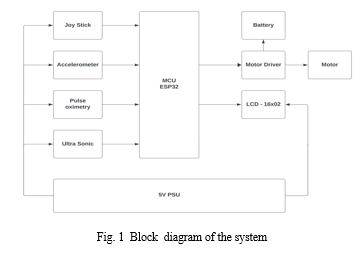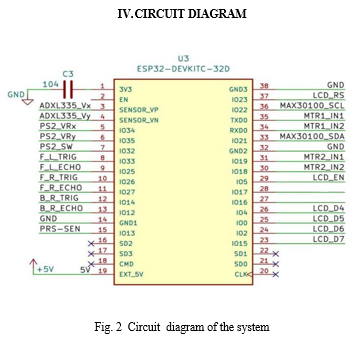Ijraset Journal For Research in Applied Science and Engineering Technology
- Home / Ijraset
- On This Page
- Abstract
- Introduction
- Conclusion
- References
- Copyright
E Wheel: A Smart Wheelchair
Authors: Anitha Mathew, Edison Varghese, Navin Babu, Mrudhula P V, Namitha C N
DOI Link: https://doi.org/10.22214/ijraset.2024.61238
Certificate: View Certificate
Abstract
In this project, we propose the development of an innovative smart electric wheelchair tailored to address the needs of individuals with mobility impairments. The primary objective is to enhance their quality of life and promote independence through the integration of cutting-edge technologies. The wheelchair\'s standout feature lies in its incorporation of advanced control mechanisms, notably head gesture control. This intuitive navigation system allows users to maneuver the wheelchair effortlessly, while also offering joystick controls. Furthermore, the wheelchair integrates a pulse oximeter sensor, enabling real-time health monitoring. This functionality is crucial for individuals with mobility impairments who may require continuous monitoring of vital signs such as oxygen saturation and heart rate. The inclusion of Blink facilitates remote monitoring and caregiver alerts, providing peace of mind to both users and their caregivers. Safety is paramount in the design of this wheelchair. To ensure safe navigation in various environments, the wheelchair is equipped with obstacle detection and protection mechanisms. These features help prevent collisions and accidents, thereby enhancing user safety. Additionally, presence sensing technology has been incorporated to detect the presence of nearby individuals or objects, further reducing the risk of accidents. Overall, this project aims to deliver a comprehensive solution that seamlessly integrates advanced control mechanisms, health monitoring capabilities, and safety features. By enhancing the autonomy and well-being of wheelchair users, this smart electric wheelchair has the potential to significantly improve their overall quality of life.
Introduction
I. INTRODUCTION
The emergence of the E-Wheel addresses a critical need for autonomy among individuals with disabilities who rely on wheelchairs. This innovative technology aims to redefine mobility, granting newfound freedom and self-sufficiency. By seamlessly integrating joystick and head movement controls, users can navigate with ease and adaptability. Advanced sensors ensure real-time monitoring of battery life, mechanical condition, and obstacles, enhancing safety. Additionally, a notification system promptly alerts caregivers to vital information, such as low battery or assistance needs. The project's core focus is on developing a technologically advanced smart wheelchair with a blend of innovative features to enhance user safety and convenience. Utilizing a combination of smart head and joystick control systems, users with varying mobility impairments can navigate efficiently and comfortably. Moreover, the wheelchair incorporates a pulse oximeter sensor for real-time monitoring of vital signs, adding an extra layer of safety. This capability enables timely intervention and medical assistance in case of abnormalities detected. Furthermore, a pressure sensor system detects potential falls or accidents by analyzing changes in pressure distribution on the seat. Upon detection, alerts are sent to caregivers or emergency contacts for swift assistance, minimizing the risk of injuries. Additionally, an ultrasonic sensor system provides obstacle detection and collision avoidance capabilities, enhancing user autonomy and safety. By automatically detecting obstacles in the wheelchair's path, it triggers alerts or corrective actions to prevent collisions. In conclusion, the smart wheelchair project offers a comprehensive solution for individuals with mobility impairments, integrating advanced control mechanisms, health monitoring capabilities, fall detection, and obstacle avoidance features. Through the utilization of cutting-edge technology, the wheelchair aims to enhance user independence, safety, and overall quality of life.
II. LITERATURE REVIEW
IoT based smart wheelchair for disabled people by T. Maryam Amur and Suresh Manic :This paper proposes a cost-effective Smart Wheelchair based on Arduino Nano microcontroller and IoT technology, integrating features such as fall detection, obstacle detection, voice recognition, and joystick control to enhance mobility for disabled individuals, particularly those unable to afford expensive alternatives[1].This system can be improved by adding features like head gesture control, real-time health monitoring, remote monitoring via Blink, obstacle detection, and presence sensing, aimed at significantly improving user autonomy and safety. Human Machine Interface Wheelchair By Using WI-FI Communication for Disabled Person by Sasikala P: This paper proposes the development of an Android-based automated wheelchair system for individuals with disabilities. The system allows control via smartphone, utilizing features like technology [2].
The system can be improvised by using a head motion sensor. This will make it easier to control for the user. Additional features like obstacle detection and health monitoring will help to build a more efficient wheelchair. IoT based smart wheelchair system by Nemil Panchamia, Shreyas Shah, Jainam Shastri, Archana Chaugule: This paper proposes an IoT-based smart chair system equipped with sensors like a microcontroller, Wi-Fi module, and inaudible sensors to detect falls among individuals, particularly those prone to falling due to factors like weak bones and weakness. [3]. This system can be improved by upgrading it into a smart electric wheelchair design catering to individuals with mobility impairments, boasting advanced features like head gesture control alongside joystick navigation. It will significantly enhance safety and convenience by integrating real-time health monitoring, obstacle detection, and comprehensive notification systems, aiming to maximize user autonomy and overall well-being. Assistive wheelchair navigation by U. Cortés, C. Urdiales, R. Annicchiarico, C. Barrué, A.B. Martinez, C. Caltagirone: This paper proposes to assess the performance of assistive wheelchair navigation systems by evaluating the control exerted by users with different pathologies. By reviewing various approaches and conducting experimental evaluations, the study seeks to enhance the independence and autonomy of individuals with mobility impairments, particularly in light of the aging population and rising prevalence of chronic diseases[4].This system can be improvised by introducing additional features such as real-time health monitoring through a pulse oximeter sensor and advanced safety mechanisms including fall detection and pressure sensor systems. These enhancements provide a more comprehensive solution to address the needs of individuals with mobility impairments, further improving their autonomy, safety, and overall quality of life. Wheelchair control by head motion by Aleksandar Pajkanovic : This paper introduces a microcontroller system that allows individuals with severe impairments, like quadriplegia, to control standard electric wheelchairs using head motion. It includes both electronic and mechanical components, along with a unique head motion recognition technique based on accelerometer data processing, tested and verified through experiments detailed in the study[5]. This system can be improved by introducing a more sophisticated control system that combines both head gesture control and traditional joystick controls, enhancing adaptability and ease of navigation for users with varying degrees of mobility impairments. Additionally, it integrates advanced health monitoring features like real-time vital sign monitoring with a pulse oximeter sensor and remote monitoring capabilities with Blink, providing a more comprehensive solution for enhancing user safety and well-being compared to previous designs. The autonomous mobile robot senario-A sensor aided intelligent navigation system for powered wheelchairs by N.I. Katevas, N.M. Sgouros, S.G. Tzafestas, G. Papakonstantinou, P. Beattie, J.M. Bishop, P. Tsanakas, D. Koutsouris: The paper outlines the development of the scenario project, which aims to enhance navigation for powered wheelchairs using sensor technology. It introduces both semi-autonomous and fully autonomous modes, enabling users to control the wheelchair manually or execute high-level commands for independent navigation[6].This system can be improvised by integrating advanced features such as joystick and head movement controls, real-time monitoring of battery life and mechanical condition, and a comprehensive notification system for caregivers. Additional features like pulse oximeters will help to monitor the health condition of the user.
III. BLOCK DIAGRAM


V. SCOPE
The future scope of the smart electric wheelchair project involves advancing various key aspects to enhance mobility assistance for individuals with disabilities. Firstly, efforts will concentrate on refining control mechanisms to offer more intuitive and responsive navigation options. This includes exploring new sensor technologies such as facial recognition or voice commands to expand accessibility choices. Additionally, integrating additional sensors for health monitoring will provide users and caregivers with comprehensive real-time health data. Future iterations may incorporate advanced sensors and analytics for personalized health insights. Moreover, advancements in AI and robotics will enable the development of smart wheelchairs capable of autonomous navigation. Leveraging machine learning algorithms and sensor fusion techniques will empower wheelchairs to navigate complex environments independently, enhancing user autonomy. Furthermore, leveraging IoT technologies and cloud computing will enhance connectivity and data analysis capabilities. This includes providing insights into user behavior, health trends, and environmental conditions for personalized recommendations. Furthermore, future iterations will prioritize adaptability and customization, allowing users to personalize their wheelchairs based on preferences and requirements. Modular designs and adjustable features will enhance comfort and usability. Finally, integrating smart home ecosystems will create a holistic environment for users, offering seamless connectivity with home automation systems, voice assistants, and wearable devices to enhance convenience and accessibility. Through these advancements, the project aims to empower users, promote independence, and improve overall quality of life for individuals with disabilities.
Conclusion
E Wheel is an innovative smart electric wheelchair tailored to meet the specific needs of individuals with mobility impairments. Our primary goal is to enrich their quality of life and foster independence by harnessing cutting-edge technologies. At the heart of our wheelchair\'s design is its advanced control mechanisms, notably the integration of head gesture control alongside joystick functionality. This dual-control system ensures accessibility for users of varying abilities, enabling effortless navigation and control. Moreover, the integration of a pulse oximeter sensor enables real-time health monitoring, a critical feature for individuals requiring continuous tracking of vital signs like oxygen saturation and heart rate. With the inclusion of Blink, remote monitoring and caregiver alerts are facilitated, offering reassurance and peace of mind to both users and their caregivers. Safety remains a paramount consideration throughout the design process. To mitigate risks in diverse environments, our wheelchair boasts obstacle detection and protection mechanisms, effectively preventing collisions and accidents. Additionally, presence sensing technology enhances safety by detecting nearby individuals or objects, further reducing the risk of potential hazards. Overall, our project endeavors to deliver a comprehensive solution that seamlessly integrates advanced control mechanisms, health monitoring capabilities, and safety features. By prioritizing the autonomy and well-being of wheelchair users, our smart electric wheelchair holds immense potential to significantly enhance their overall quality of life. Looking ahead, our commitment to innovation and collaboration will drive ongoing refinements and enhancements to our wheelchair design. Through continued efforts, we aim to push the boundaries of accessibility, independence, and inclusivity, ultimately empowering individuals with mobility impairments to lead more autonomous lives.
References
[1] T. Maryam Amur and Suresh Manic, IoT Based Smart Wheelchair for Disabled People, International Conference on System, Computation, Automation and Networking, July 2021 [2] Sasikala P,Human Machine Interface Wheelchair By Using WI-FI Communication for Disabled Person,Fourth International Conference on Electronics, Communication and Aerospace Technology ,2020 [3] Nemil Panchamia, Shreyas Shah, Jainam Shastri, Archana Chaugule,IOT Based Smart Wheelchair System,S. Muruganand Journal of VLSI Design and its Advancement. [4] U. Cortés, C. Urdiales, R. Annicchiarico, C. Barrué, A.B. Martinez, C. Caltagirone,Assistive Wheelchair Navigation: A Cognitive View, Studies in Computational Intelligence,Advanced Computational Intelligence Paradigms in Healthcare – 1, Vol. 48, 2007, pp. 165 – 187. [5] Aleksandar Pajkanovic,Wheelchair control by head motion,January 2013,Serbian Journal of Electrical Engineering 10(1):135-151,DOI:10.2298/SJEE1301135P [6] N.I. Katevas, N.M. Sgouros, S.G. Tzafestas, G. Papakonstantinou, P. Beattie, J.M. Bishop,P. Tsanakas, D. Koutsouris,The Autonomous Mobile Robot senario: A Sensor Aided Intelligent Navigation System for Powered Wheelchairs, IEEE Robotics and Automation,Magazine, Vol. 4, No. 4, Dec. 1997, pp. 60 – 70.
Copyright
Copyright © 2024 Anitha Mathew, Edison Varghese, Navin Babu, Mrudhula P V, Namitha C N. This is an open access article distributed under the Creative Commons Attribution License, which permits unrestricted use, distribution, and reproduction in any medium, provided the original work is properly cited.

Download Paper
Paper Id : IJRASET61238
Publish Date : 2024-04-29
ISSN : 2321-9653
Publisher Name : IJRASET
DOI Link : Click Here
 Submit Paper Online
Submit Paper Online

